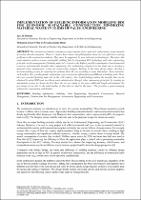Chapter Implementation of Building Information Modeling (BIM) for Economic Sustainable Construction Minimizing Material Waste in Terms of Value Engineering
| dc.contributor.author | Shihata, Aya Ali | |
| dc.contributor.author | Fekry, Mohamed Anwar | |
| dc.contributor.author | Abbas, Wessam Hamdy | |
| dc.date.accessioned | 2024-04-02T15:47:47Z | |
| dc.date.available | 2024-04-02T15:47:47Z | |
| dc.date.issued | 2023 | |
| dc.identifier | ONIX_20240402_9791221502893_111 | |
| dc.identifier.issn | 2704-5846 | |
| dc.identifier.uri | https://library.oapen.org/handle/20.500.12657/89142 | |
| dc.description.abstract | The construction industry consumes a large amount of raw materials and produces large amounts of carbon dioxide emissions. However, studies have shown that philosophies alone are not efficient in solving problems in the construction industry. They must be supported by new tools and methodologies. Therefore, this study aimed to achieve a more sustainable building field by integrating BIM technology and value engineering principles in the management of building materials. to achieve the highest possible consumption of environmental resources and materials through value engineering. The methodology employed in this study was to develop a material waste management system for construction projects. Starting in the early design phase, develop a decision-making process for selecting the optimum floor tile size according to room dimensions. Some materials, such as floor tiles, wooden panels, and marble, can be used more efficiently using BIM and scheduling tools. Floor tiles are essential finishing materials in the AEC industry. The initial findings outline the benefits that can be obtained by using BIM tools to achieve waste minimization through value engineering principles by creating an automation process to choose the best floor tile size according to the space width and length and minimize the percentage of cut tiles to the total number of tiles that are used in the space. This provides a game-changing solution for construction stakeholders | |
| dc.language | English | |
| dc.relation.ispartofseries | Proceedings e report | |
| dc.subject.classification | thema EDItEUR::U Computing and Information Technology::UT Computer networking and communications::UTV Virtualization | |
| dc.subject.other | Building Information Modeling | |
| dc.subject.other | Value Engineering | |
| dc.subject.other | Sustainable Construction | |
| dc.subject.other | Material Management | |
| dc.subject.other | Construction Site Management | |
| dc.subject.other | Architectural Engineering and Construction | |
| dc.title | Chapter Implementation of Building Information Modeling (BIM) for Economic Sustainable Construction Minimizing Material Waste in Terms of Value Engineering | |
| dc.type | chapter | |
| oapen.identifier.doi | 10.36253/979-12-215-0289-3.103 | |
| oapen.relation.isPublishedBy | bf65d21a-78e5-4ba2-983a-dbfa90962870 | |
| oapen.relation.isbn | 9791221502893 | |
| oapen.series.number | 137 | |
| oapen.pages | 9 | |
| oapen.place.publication | Florence |

